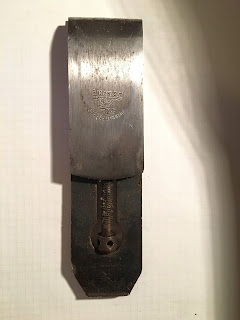Few days ago, I received an email from Simon living in Netherlands about the dimensions of one of my Peugeot plane. Simon got a Peugeot blade assembly and wants to build the plane that goes along. So I made some pictures and drawings with measurements and here is the anatomy of a Peugeot plane.
Introduction
 |
| Peugeot 48 |
The plane is a Peugeot 48 (what is also the blade width measured in mm) and is made with Cormier wood (French naming) or Service Tree in English. For the naturalists, its scientific name is Sorbus Domestica.
Its length is about 93/8 inches (or about 238mm) what makes it a smoother plane.
Its particularity is the mechanism to move the blade.
 |
| Blade assembly, top view |
 |
| Blade assembly, side view |
I tried to be as precise as possible in my measurements, in inches as well as millimeters, but there may be some small deviations.
Side view
The picture below shows the side view of the plane wooden body (blade assembly and wedge removed).
 |
| Plane body, side view. |
Below is a drawing with all the dimensions I was able to measure.
 |
| Plane body side dimensions. |
One thing that surprised me is the 80 degrees angle of the front side of the mouth that I believed was vertical but is not.
Top view
Below is a picture of the plane body top view.
 |
| Plane body, top view |
 |
| Plane body top dimensions |
About the wedge
Below are two pictures of the plane wedge. Sorry for the shadow but I have no professional studio light so this as the best I could do.
 |
| Wedge, top view |
 |
| Wedge, side view |
 |
| Wedge dimensions |

